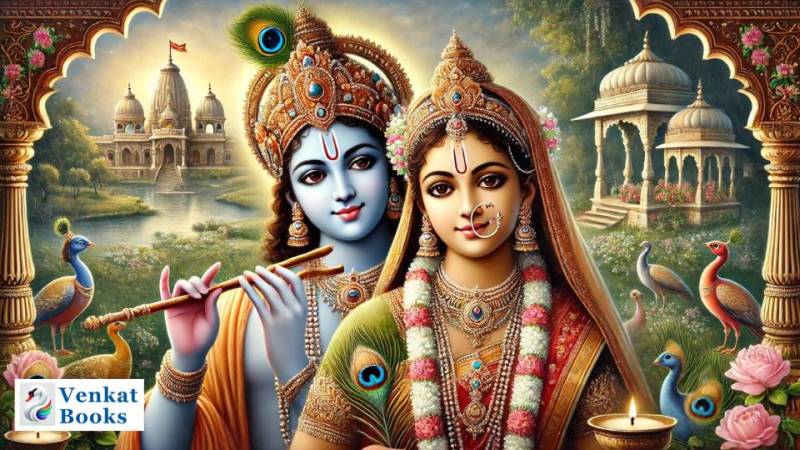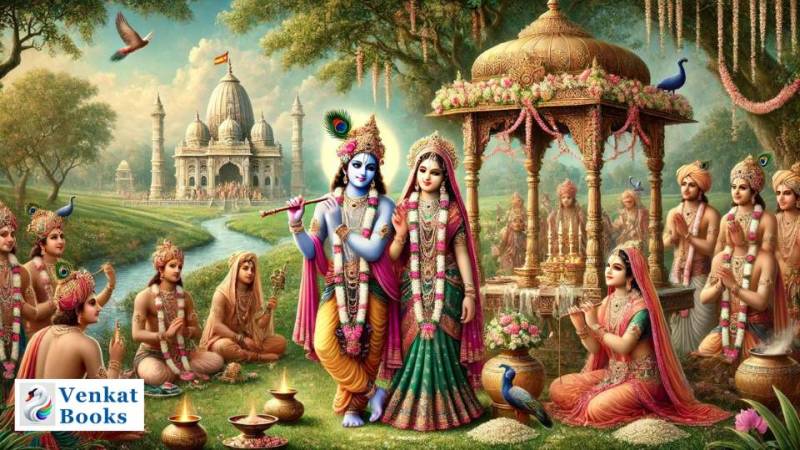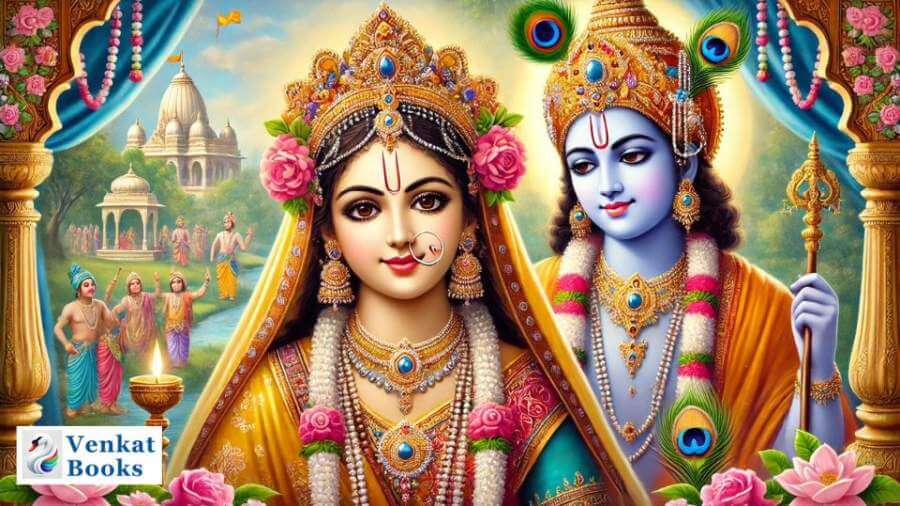Why is Radhashtami celebrated?
In the Hindu religion, Radhashtami is a festival dedicated to Radharani, Lord Krishna’s everlasting consort, and has great spiritual significance. Radhashtami is a day on which devotees from all over the world gather to worship Radha, who is revered as the embodiment of divine love and devotion. It falls on the eighth day of the bright fortnight (Shukla Paksha) in the month of Bhadrapada, which is often around August or September.
Gaudiya Vaishnavism devotees, who see Radha as the ultimate manifestation of bhakti (devotion) as well as Krishna’s beloved, particularly treasure this holy day. Radha’s love for Krishna is a symbol of the soul’s desire for unification with the Divine and transcends the physical realm.
Radha Krishna Books
- The first book to cover Krishna’s entire life, from his childhood pranks to his final powerful acts in the Mahabharata war • Draws from the Bhagavad Purana, the Bhagavad Gita, the Mahabharata, and India’s sacred oral tradition • Shows how the stories of Krishna’s life are expressed with such simplicity and humor that they enable anyone–man, woman, or child–to see the wisdom of his teachings • Provides a valuable meditative tool that allows the lessons of these stories to illuminate from within Krishna, one of the most beloved characters of the Hindu pantheon, has been portrayed in many lights: a god-child, a prankster, a model lover, a divine hero, an exemplary ruler, and the Supreme Being
- In The Complete Life of Krishna, Vanamali, a leading Krishna expert from a long line of prominent Krishna devotees, provides the first book in English or Sanskrit to cover the complete range of the avatar’s life
- Drawing from the Bhagavad Purana, the Bhagavad Gita, the Mahabharata, and India’s sacred oral tradition, Vanamali shares stories from Krishna’s birth in a dungeon and early days as a merry trickster in Vrindavana, through his time as divine ruler at Dwaraka, to his final powerful acts as the hero Arjuna’s charioteer and guru in the Kurukshetra war
- She explains how Krishna became a mahayogi, the greatest of all yogis, and attained complete mastery over himself and nature
- By integrating the hero-child with the mahayogi, the playful lover with the divine ruler, Vanamali shows how the stories of Krishna’s life are expressed with such simplicity and humor that they enable anyone–man, woman, or child–to see the wisdom of his teachings
The Inherent Spirituality of Radhashtami
Radhashtami provides an exceptional perspective for examining the purest type of devotion: selfless, unconditional love. Because of her unwavering love for Krishna, which is free of ego, anticipation, and attachment to material things, Radha is frequently described to as the ultimate devotee. The cosmic interaction between the soul and the Supreme is reflected in her relationship with Krishna, which is an endless and glorious dance.
Krishna is regarded in Hinduism as the Absolute Consciousness, the spiritual essence that permeates the cosmos. Alternatively, Radha represents the individual soul (jivatma) that aspires to union with the Paramatma (Supreme Soul), Krishna. Their coupling symbolizes the spiritual path that every soul goes through to discover its actual, divine essence.

Radha in Vaishnava Tradition
Radha is revered greatly in Vaishnavism, particularly in the Gaudiya Vaishnava tradition. In addition to Krishna’s function as the Shaktiman—the one who possesses divine power—she is considered as the embodiment of the divine feminine force, or Shakti. A major topic in Hinduism is the cosmic balance between Shakti and Shaktiman, which stands for the interdependent energies of creation, preservation, and annihilation in the cosmos.
It is said that Radha’s devotion to Krishna represents the pinnacle of devotional service. It is a love that has no bounds to space, time, or the physical world. Her dedication is an example of the purest surrender, where the individual loses all sense of separation from the cosmic awareness and dissolves into it.
The Significance of Radha and Krishna’s Love
In addition to being a romantic narrative, Radha and Krishna’s love story is a profound spiritual allegory. Many people interpret Radha’s love for Krishna as a metaphor for the soul’s desire for God. The soul yearns to be reunited with its source, the Divine, just as Radha yearns for Krishna to be in her life. The devotional method known as bhakti yoga is centered around this unending need.
Radhashtami reminds us that true love is about dedication and selflessness rather than ownership. Radha’s unwavering devotion is based on her desire to serve Krishna and unite with him. In a similar vein, the soul’s path is about uniting with the divine flow of the universe via selfless activity and unwavering commitment rather than obtaining material prosperity or power.
Celebrations and Customs Around Radhashtami
Radhashtami celebrations are characterized by devotion, happiness, and introspection. Radha-Krishna mantras are chanted, fasts are observed, and prayers are offered on Radhashtami by devotees. Devotional singing (bhajans), kirtans, and processions that honor Radharani’s divine presence bring temples—especially those in Vrindavan, Barsana, and other holy locations—to life.
Temples are embellished with lights, flowers, and exquisite representations of Radha and Krishna. To obtain the blessings of Radharani, who is revered as a loving and compassionate force in the lives of her devotees, special pujas (rituals) are conducted. Radha’s idol is covered with ghee, milk, and honey to represent her holy essence and purity.
Celebrations have a unique meaning in Vrindavan, the location of Radha and Krishna’s celestial adventures. Barsana, which is thought to be Radha’s birthplace, becomes the center of lavish celebrations. These holy locations are visited by devotees from all over India and the globe who come to offer prayers and ask Radharani’s blessings.

Meditation and Fasting remembering Goddess Radha
Among devotees, fasting on Radhashtami is a custom. The goal of this fast is to cleanse the body and mind so that all attention can be directed toward the heavenly love of Radha and Krishna, rather than just forgoing food. After the midday puja and the rites and offerings to Radharani, the fast is usually broken.
A lot of devotees meditate throughout the day, emphasizing the spiritual significance of Radha’s love for Krishna. Chanting mantras, like the Hare Krishna Mahamantra, enables believers to feel the ecstasy of devotion and strengthen their bond with the holy.
A Call to Unselfish Love and Devotion from Radhashtami
Radhashtami is a spiritual reminder to practice selfless love and devotion in our lives rather than only a religious holiday. Love that gives without expecting anything in return is the purest kind, as Radha reminds us. It is a love that arises from a profound sense of unity with the Divine, in which the soul unites with the cosmic dance of creation and the ego vanishes.
In the modern world, when worldly goals frequently take precedence over spiritual development, Radhashtami provides a sobering reminder. It reminds us that devotion—whether to a personal deity, a higher force, or a worthy cause—can be the route to ultimate serenity and fulfillment and challenges us to consider the true nature of love.
Radha’s devotedness to Krishna demonstrates to us that love is about service and surrender rather than attachment or control. It is about dedicating our lives to the search of spiritual truth and acknowledging the divine in everything and everyone.
Wisdom of Radha
We are reminded of Radha’s timeless message—that love and dedication are the greatest characteristics we can pursue—as we commemorate Radhashtami. Her example teaches us that letting go of our ego and choosing the route of selfless service is the first step toward achieving true happiness and spiritual liberation.
Radhashtami is a call to reestablish a connection with the divine, let go of material attachments, and feel the joy of being one with the divine. Whether we spend this day in a temple, in meditation at home, or just thinking back on the tale of Radha and Krishna, it is an incredibly meaningful chance to strengthen our spiritual practices and unite our hearts with the boundless love of the cosmos.
Radha’s love for Krishna is greater than time, distance, and all other constraints of this world, serving as a constant reminder that, in the end, we are all one with the Divine.


